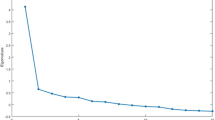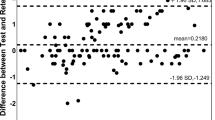Abstract
Purpose
The aim of this study was to cross-culturally adapt the Neck Bournemouth Questionnaire in Italian (NBQ-I) and validate its psychometric properties in a sample of subjects with chronic neck pain.
Methods
The NBQ-I was developed according to international standards. The psychometric testing included the content validity, assessed by considering the relevance and comprehensiveness of the items, the structural validity by factor analysis, the construct validity and the responsiveness by mean of hypotheses testing process comparing, respectively, the test scores and the changes scores of the NBQ-I with those of the Neck Pain and Disability Scale, the Numerical Rating Scale for Pain, the EuroQoL 5 Dimension Index and its numerical rating scale. Finally, we tested the reliability by internal consistency (Cronbach’s α) and the interpretability by calculating the Minimal Clinical Important Difference (MCID).
Results
The NBQ-I had acceptable psychometric characteristics. A total of 96 subjects with chronic neck pain completed the questionnaire’s administration. The high relevance and comprehensiveness of the items pointed out acceptable face validity. The construct validity analysis was based on the structural validity, which revealed a two factors structure explaining 69.2 % of variance, and on the hypotheses testing process, which showed a moderate validity. The internal consistency was acceptable (α = 0.89). The responsiveness, assessed with the hypotheses testing process, was moderate. The MCID was 5.5 points.
Conclusions
The validation process revealed acceptable psychometric properties of the NBQ, whose Italian version can be used for research and clinical purposes.
Similar content being viewed by others
References
Hogg-Johnson, S., van der Velde, G., Carroll, L. J., Holm, L. W., Cassidy, J. D., Guzman, J., et al. (2008). The burden and determinants of neck pain in the general population: results of the Bone and Joint Decade 2000–2010 Task Force on Neck Pain and Its Associated Disorders. Spine (Phila Pa 1976), 33(4 Suppl), S39–S51.
Hush, J. M., Lin, C. C., Michaleff, Z. A., Verhagen, A., & Refshauge, K. M. (2011). Prognosis of acute idiopathic neck pain is poor: A systematic review and meta-analysis. Archives of Physical Medicine and Rehabilitation, 92(5), 824–829.
Driessen, M. T., Lin, C. W., & van Tulder, M. W. (2012). Cost-effectiveness of conservative treatments for neck pain: A systematic review on economic evaluations. European Spine Journal, 21(8), 1441–1450.
Borghouts, J. A., Koes, B. W., Vondeling, H., & Bouter, L. M. (1999). Cost-of-illness of neck pain in The Netherlands in 1996. Pain, 80(3), 629–636.
Van Eerd, D., Cote, P., Kristman, V., Rezai, M., Hogg-Johnson, S., Vidmar, M., et al. (2011). The course of work absenteeism involving neck pain: a cohort study of Ontario lost-time claimants. Spine (Phila Pa 1976), 36(12), 977–982.
World Health Organization. (2001). ICF : International classification of functioning, disability and health/World Health Organization. Geneva: World Health Organization.
Ferreira, M. L., Borges, B. M., Rezende, I. L., Carvalho, L. P., Soares, L. P., Dabes, R. A., et al. (2010). Are neck pain scales and questionnaires compatible with the international classification of functioning, disability and health? A systematic review. Disability and Rehabilitation, 32(19), 1539–1546.
Vernon, H., & Mior, S. (1991). The Neck Disability Index: A study of reliability and validity. Journal of Manipulative and Physiological Therapeutics, 14(7), 409–415.
Wheeler, A. H., Goolkasian, P., Baird, A. C., & Darden, B. V, 2nd. (1999). Development of the Neck Pain and Disability Scale. Item analysis, face, and criterion-related validity. Spine (Phila Pa 1976), 24(13), 1290–1294.
Bolton, J. E., & Humphreys, B. K. (2002). The Bournemouth Questionnaire: a short-form comprehensive outcome measure. II. Psychometric properties in neck pain patients. Journal of Manipulative and Physiological Therapeutics, 25(3), 141–148.
Soklic, M., Peterson, C., & Humphreys, B. K. (2012). Translation and validation of the German version of the Bournemouth Questionnaire for Neck Pain. Chiropractic & Manual Therapies, 20(1), 2.
Martel, J., Dugas, C., Lafond, D., & Descarreaux, M. (2009). Validation of the French version of the Bournemouth Questionnaire. Journal of the Canadian Chiropractic Association, 53(2), 102–120.
Schmitt, M. A., de Wijer, A., van Genderen, F. R., van der Graaf, Y., Helders, P. J., & van Meeteren, N. L. (2009). The Neck Bournemouth Questionnaire cross-cultural adaptation into Dutch and evaluation of its psychometric properties in a population with subacute and chronic whiplash associated disorders. Spine (Phila Pa 1976), 34(23), 2551–2561.
Mokkink, L. B., Terwee, C. B., Patrick, D. L., Alonso, J., Stratford, P. W., Knol, D. L., et al. (2010). The COSMIN study reached international consensus on taxonomy, terminology, and definitions of measurement properties for health-related patient-reported outcomes. Journal of Clinical Epidemiology, 63(7), 737–745.
Kline, P. (1993). The handbook of psychological testing. London: Routledge.
Beaton, D. E., Bombardier, C., Guillemin, F., & Ferraz, M. B. (2000). Guidelines for the process of cross-cultural adaptation of self-report measures. Spine (Phila Pa 1976), 25(24), 3186–3191.
Monticone, M., Baiardi, P., Nido, N., Righini, C., Tomba, A., & Giovanazzi, E. (2008). Development of the Italian version of the Neck Pain and Disability Scale, NPDS-I: cross-cultural adaptation, reliability, and validity. Spine (Phila Pa 1976), 33(13), E429–E434.
Savoia, E., Fantini, M. P., Pandolfi, P. P., Dallolio, L., & Collina, N. (2006). Assessing the construct validity of the Italian version of the EQ-5D: preliminary results from a cross-sectional study in North Italy. Health and Quality of Life Outcomes, 4, 47.
Huskisson, E. C. (1974). Measurement of pain. Lancet, 2(7889), 1127–1131.
R Core Team. (2013). R: A language and environment for statistical computing. Vienna, Austria: R Foundation for Statistical Computing.
Mokkink, L. B., Terwee, C. B., Knol, D. L., Stratford, P. W., Alonso, J., Patrick, D. L., et al. (2010). The COSMIN checklist for evaluating the methodological quality of studies on measurement properties: a clarification of its content. BMC Medical Research Methodology, 10, 22.
Browne, M. W., & Cudeck, R. (1993). Alternative ways of assessing model fit. In K. A. Bollen & J. S. Long (Eds.), Testing structural equation models (pp. 136–162). London: Sage Ltd.
Brown, T. A. (2006). Confirmatory factor analysis for applied research. New York: The Guilford Press.
de Boer, M. R., Moll, A. C., de Vet, H. C., Terwee, C. B., Volker-Dieben, H. J., & van Rens, G. H. (2004). Psychometric properties of vision-related quality of life questionnaires: a systematic review. Ophthalmic and Physiological Optics, 24(4), 257–273.
Streiner, D. L. (2003). Starting at the beginning: an introduction to coefficient alpha and internal consistency. Journal of Personality Assessment, 80(1), 99–103.
McHorney, C. A., & Tarlov, A. R. (1995). Individual-patient monitoring in clinical practice: are available health status surveys adequate? Quality of Life Research, 4(4), 293–307.
Revicki, D., Hays, R. D., Cella, D., & Sloan, J. (2008). Recommended methods for determining responsiveness and minimally important differences for patient-reported outcomes. Journal of Clinical Epidemiology, 61(2), 102–109.
Terwee, C. B., Bot, S. D., de Boer, M. R., van der Windt, D. A., Knol, D. L., Dekker, J., et al. (2007). Quality criteria were proposed for measurement properties of health status questionnaires. Journal of Clinical Epidemiology, 60(1), 34–42.
Gay, R. E., Madson, T. J., & Cieslak, K. R. (2007). Comparison of the Neck Disability Index and the Neck Bournemouth Questionnaire in a sample of patients with chronic uncomplicated neck pain. Journal of Manipulative and Physiological Therapeutics, 30(4), 259–262.
Bolton, J. E. (2004). Sensitivity and specificity of outcome measures in patients with neck pain: detecting clinically significant improvement. Spine (Phila Pa 1976), 29(21), 2410–2417.
Gemmell, H., & Miller, P. (2010). Relative effectiveness and adverse effects of cervical manipulation, mobilisation and the activator instrument in patients with sub-acute non-specific neck pain: results from a stopped randomised trial. Chiropractic & Osteopathy, 18, 20.
Schellingerhout, J. M., Verhagen, A. P., Heymans, M. W., Koes, B. W., de Vet, H. C., & Terwee, C. B. (2012). Measurement properties of disease-specific questionnaires in patients with neck pain: a systematic review. Quality of Life Research, 21(4), 659–670.
Schellingerhout, J. M., Heymans, M. W., Verhagen, A. P., de Vet, H. C., Koes, B. W., & Terwee, C. B. (2011). Measurement properties of translated versions of neck-specific questionnaires: a systematic review. BMC Medical Research Methodology, 11, 87.
Acknowledgements
We want to gratefully thank Rosaria Carioti for her organizational competences and the librarians of the University of Florence and Genua for their support in retrieving some of the cited articles.
Author information
Authors and Affiliations
Corresponding author
Rights and permissions
About this article
Cite this article
Geri, T., Signori, A., Gianola, S. et al. Cross-cultural adaptation and validation of the Neck Bournemouth Questionnaire in the Italian population. Qual Life Res 24, 735–745 (2015). https://doi.org/10.1007/s11136-014-0806-5
Accepted:
Published:
Issue Date:
DOI: https://doi.org/10.1007/s11136-014-0806-5




